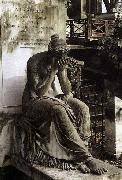Wholesale Oil Painting No Minimum |
|||||||||||
|
|
|||||||||||

|
|||||||||||
|
|
|
||||||||
|
|
||||||||
Sorrow
Sorrow Painting ID:: 62411 |
1816 Marble, height 135 cm P?re-Lachaise Cemetery, Paris The P?re-Lachaise Cemetery in Paris, opened in 1804, was soon covered with monuments and these, together with the beauty of the site and the many plants and shrubs surrounding the tombs, made it during the romantic period a popular resort on half-days and holidays. Under the Ancien R?gime, people sought to ensure their salvation by endowing foundations; in the nineteenth century, their successors were anxious above all that their memory should not die, oblivion being in their eyes ultimate death. The decree law of 1804, followed by the creation of the big cemeteries outside the city walls, was an expression of this new materialistic form of respect for the dead and guaranteed the success of the sale of burial plots in perpetuity and monuments designed to preserve - and extol - the memory of the deceased. In keeping with this trend, images depicting Death were seldom placed in cemeteries. On the other hand, the representation of Grief, am indirect way of paying tribute to the dead, is a favourite theme very much in evidence in funerary sculpture, expressed sometimes in allegorical, sometimes in narrative form. As early as 1816 Milhomme created a fine figure expressing the sorrow of the widow and six children of Pierre Gareau, killed in an accident. The Milhomme figure begot many more of the same kind, but the scenes of affliction came to an end with the years 1820-25. Author: MILHOMME, Fran?ois-Dominique-Aim? Title: Sorrow, Tomb of Pierre Gareau Form: sculpture , 1801-1850 , French , religious 1816 Marble, height 135 cm P?re-Lachaise Cemetery, Paris The P?re-Lachaise Cemetery in Paris, opened in 1804, was soon covered with monuments and these, together with the beauty of the site and the many plants and shrubs surrounding the tombs, made it during the romantic period a popular resort on half-days and holidays. Under the Ancien R?gime, people sought to ensure their salvation by endowing foundations; in the nineteenth century, their successors were anxious above all that their memory should not die, oblivion being in their eyes ultimate death. The decree law of 1804, followed by the creation of the big cemeteries outside the city walls, was an expression of this new materialistic form of respect for the dead and guaranteed the success of the sale of burial plots in perpetuity and monuments designed to preserve - and extol - the memory of the deceased. In keeping with this trend, images depicting Death were seldom placed in cemeteries. On the other hand, the representation of Grief, am indirect way of paying tribute to the dead, is a favourite theme very much in evidence in funerary sculpture, expressed sometimes in allegorical, sometimes in narrative form. As early as 1816 Milhomme created a fine figure expressing the sorrow of the widow and six children of Pierre Gareau, killed in an accident. The Milhomme figure begot many more of the same kind, but the scenes of affliction came to an end with the years 1820-25. Author: MILHOMME, Fran?ois-Dominique-Aim? Title: Sorrow, Tomb of Pierre Gareau Form: sculpture , 1801-1850 , French , religious |
|||||||
|
|
||||||||
|
Jacques-Louis David French b.Aug. 30, 1748, Paris d.Dec. 29, 1825, Brussels Jacques-Louis David is famous for his huge, dramatic canvasses of Napoleon and other historical figures, including Oath of the Horatii (1784), Death of Marat (1793) and The Sabine Women (1799). Early in his career he was a leader in the neoclassical movement; later his subjects became more modern and political. David was himself active in the French Revolution as a supporter of Robespierre and is sometimes called the chief propagandist for the Revolution; after the Reign of Terror ended he was briefly imprisoned for his actions. When Napoleon took power David became his court painter and created several grand canvasses of the Emperor, including the heroic Napoleon Bonaparte Crossing the Alps (1801) and the enormous Coronation of Napoleon and Josephine (1807). David also painted Napoleon in His Study (1812), with its famous image of Napoleon with one hand tucked inside his vest. After Napoleon ouster David went in exile to Brussels, where he remained until his 1825 death Sorrow 535 x 410 mm ?cole Nationale Sup?rieure des Beaux-Arts, Paris Although defeated in the Prix de Rome in 1773, David had the satisfaction of winning the prize for the best drawing of an expressive head, with his image of Sorrow. Author: DAVID, Jacques-Louis Title: Sorrow Form: graphics , 1801-1850 , French , portrait |
||||||||
|
|
||||||||
|
Prev Next
|
||||||||
|
|
||||||||
|
Related Paintings to Jacques-Louis David :. |
||||||||
|
|
||||||||
|
CONTACT US |

